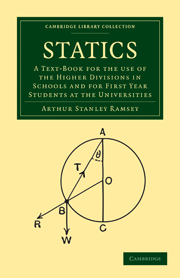 Statics
Statics Published online by Cambridge University Press: 07 September 2010
Friction between two bodies in contact at a point was defined in 3.7 as that part of the mutual reaction between the bodies which lies in the tangent plane at the point of contact. When two bodies are in contact over a plane area on the surface of each body, the mutual reaction between them is in general a force acting at some point of this area, and its component, if any, in the plane of contact is called Friction.
The mutual reactions between bodies are passive forces in the sense that they only exist because of other forces applied to the bodies. Thus a body may stand alongside a vertical wall and in contact with it without any pressure between them until an external force presses the body against the wall and then there is a mutual reaction between the body and the wall and its amount is no more than is necessary to balance the externally applied force.
Friction, being a component of the mutual reaction, is a passive force. It prevents or tends to prevent the motion of one body across the surface of another, i.e. the relative motion of the points of contact.
Laws of Friction:
(i) Friction acts in the direction opposite to what would be the direction of relative motion if the friction did not exist; or, in the case of relative motion, the friction opposes the relative motion.
(ii) The magnitude of the friction is always just sufficient to preserve equilibrium or to prevent relative motion of the points of contact, provided that sufficient friction can be obtained.
To save this book to your Kindle, first ensure no-reply@cambridge.org is added to your Approved Personal Document E-mail List under your Personal Document Settings on the Manage Your Content and Devices page of your Amazon account. Then enter the ‘name’ part of your Kindle email address below. Find out more about saving to your Kindle.
Note you can select to save to either the @free.kindle.com or @kindle.com variations. ‘@free.kindle.com’ emails are free but can only be saved to your device when it is connected to wi-fi. ‘@kindle.com’ emails can be delivered even when you are not connected to wi-fi, but note that service fees apply.
Find out more about the Kindle Personal Document Service.
To save content items to your account, please confirm that you agree to abide by our usage policies. If this is the first time you use this feature, you will be asked to authorise Cambridge Core to connect with your account. Find out more about saving content to Dropbox.
To save content items to your account, please confirm that you agree to abide by our usage policies. If this is the first time you use this feature, you will be asked to authorise Cambridge Core to connect with your account. Find out more about saving content to Google Drive.